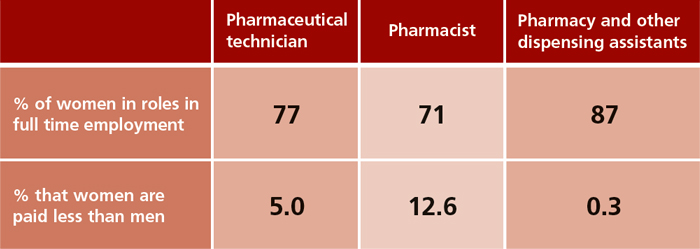Focus on gender
In Opinion
Follow this topic
Bookmark
Record learning outcomes
With the media currently dominated by stories of the gender gap and gender pay gap, Tess Fenn looks at what this means in the context of pharmacy and pharmacy technicians
The majority of staff working in the pharmacy sector are female. General Pharmaceutical Council (GPhC) data from April 2018 indicates there are 23,363 pharmacy technicians on the register, of which 20,596 (88 per cent) are female and 2,767 (12 per cent) are male. And a 2012 study found that male pharmacy technicians represent a smaller proportion of the registered technician population in Scotland and Wales than in England.

Yet, despite this and the fact that female pharmacists account for 61 per cent of the GPhC register, research published on International Women’s Day (8 March 2018) by the University of Birmingham, found that only 36 per cent of senior positions in pharmacy are held by women. Although this research focused on pharmacists, the figures correlate with a recent survey of APTUK members, which found that 35 per cent are in senior positions. However, the questions in this survey did not distinguish between female and male respondents.
The Office for National Statistics (ONS) suggests that under-representation of women in senior positions may be due to attitudes about gender roles, lack of flexible working or women taking time to look after their families. It also suggests that the gender pay gap, although complex, may be attributed to more women working in lower paid jobs or sectors and that women are more likely to work part time, which can mean a lower rate of pay.
The gender pay gap
Gender pay gap reporting is now a subject of law and, since April 2017, all employers in Great Britain with more than 250 staff are required to publish annual figures relating to the pay and bonuses of men and women.
An interactive tool on the ONS website explores the gender pay gap by occupation. The categories available for pharmacy include ‘pharmaceutical technician’, ‘pharmacist’ and ‘pharmacy and other dispensing assistants’ (see table below).

However, the gender pay gap data doesn’t say whether women are being paid less than men for the same work, which has been against the law since the Equal Pay Act (1970), nor does it clarify the pharmacy technician position. It is unclear whether ‘pharmaceutical technician’ is a pharmacy technician or whether pharmacy technicians are categorised within ‘pharmacy and other dispensing assistants’.
This further supports the need for greater clarification of roles and titles for pharmacy technicians and dispensing assistants. APTUK is firmly committed to raising this matter at every opportunity to ensure that there is accuracy and understanding of the various pharmacy team roles for the public and the profession alike.
For pharmacy, whilst the new gender pay gap reporting requirements and results are a step in the right direction, more understanding of the underlying cause is needed. Analysis of NHS staff surveys indicates that having equal opportunities for career progression or promotion provides more job satisfaction, which is then translated into the service provided to patients and therefore into patients’ overall satisfaction with their care.
While this is an important factor for all of pharmacy, it’s also a case for fully utilising the skills of pharmacy technicians as registered professionals in the pharmacy team. APTUK’s 2016 report – Identifying the Roles of Pharmacy Technicians in the UK – highlighted that community pharmacy technicians felt they had more to offer if given the opportunity.
It is essential that everyone is treated fairly not only because it is the right thing to do but also as it’s better for patients.
